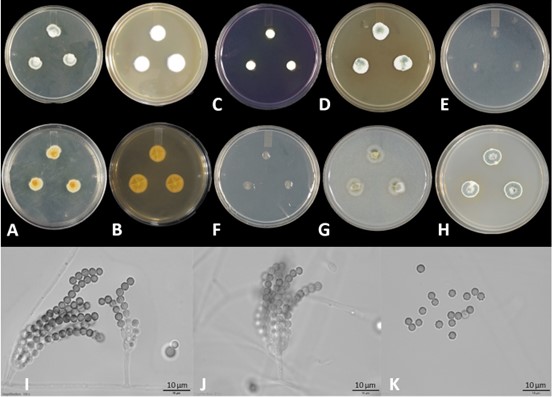Penicillium menonorum S.W. Peterson, in Peterson, Orchard & Menon IMA Fungus 2(2): 122. (2011).
MycoBank number: MB 519297; Index Fungorum number: IF 519297; Facesoffungi number: FoF 11434;
No synonyms
Description
Culture characteristics: Colonies growing after 5 days at 25 ± 2 ºC on following agar media: CYA colonies medium growing, slightly umbonate, cottony, velutinous to floccose, mycelium pea green (29D5) to greyish green (29D4), 10–11 mm in diam.; margins irregular, deep; sporulation greenish green (26D2) and white; exudates absent; soluble pigments absent; reverse filamentous, half dark green (28F8) and white colony. MEA colonies medium growing, velutinous, flat, umbonate, powdery, white, grey (27C1) with a combination of jade green (27E5) mycelia, 12−14 mm in diam.; margins irregular; sporulation greyish green (27C3), dark green (27F4) in between mycelia and sporulation; exudates absent; soluble pigments absent; reverse wrinkled, reverse mycelia brown (6E8), white sporulation. CYAS colonies moderate growing, floccose, slightly umbonate, green (28A6) mycelia, 15−18 mm in diam.; margin irregular, deep; sporulation white; exudates absent, soluble pigments absent; reverse wrinkled, reverse mycelia golden yellow (5B7), sporulation white. OA colonies slow-growing, planar, flat, cottony, suppressed, mycelia grey (28C1), 19 mm in diam.; margin irregular; sporulation white, green (28C6) between mycelia and sporulation; exudates colourless; soluble pigments absent; reverse white, mycelia clay (5D5), pastel green between mycelia and sporulation. CZ colonies slow-growing, flat, cottony, pastel yellow (3A4) mycelia, 9-10 mm in diam.; margin regular; sporulation white; exudates absent; soluble pigments absent; reverse white (1A1). DG18 colonies slow-growing, planar, flat, cottony, suppressed, mycelium white, 8–10 mm diam.; margin irregular; exudates absent; soluble pigments absent; reverse white (1A1). YES colonies fast-growing, floccose, radiating sulcation, slightly umbonate, 23–25 mm diam.; margin irregular; sporulation white, half mycelia and sporulation greyish green (28E5) and half pale green (25A3); exudates absent; soluble pigments absent; reverse wrinkled, white sporulation, half dull green (26E4) to cream (4A3) mycelia and sporulation. CREA colonies umbonate, cottony, mycelia yellowish-white (3A2), 10–12 mm in diam.; margin regular; sporulation white; exudates present, chrome yellow, signal yellow (3A8); soluble pigment pastel yellow (3A4); acid production present; reverse deep orange to orange chrome, mycelia orange, sporulation white. Conidiophores monoverticillate, smooth-walled, hyaline, 5–20 × 1.5–2.0 µm, with an apical whorl of 2–5; phialides 5–9 × 2.5–3.5 µm, conidia spherical to subspherical, 2–3.5 µm, with roughened to rugose ornamentation.
Material examined: INDIA, Meghalaya, Shillong (25°33′39″N, 91°52′57″E) from soil sample, 08 August 2018, Rajeshkumar K.C., Nikhil Ashtekar (NFCCI 5064).
Distribution: China, Korea, and USA
Sequence data from this collection: ITS: OK342221 (ITS5/ITS4); BenA: OL652650 (Bt2a/Bt2b); CaM: OM948803 (CMD5/CMD6); RPB2: NA (fRPB2-5F/fRPB2-7CR)
Notes: In the concatenated phylogenetic analyses of ITS, BenA, CaM, and RPB2 genes (Fig. xx) showed that our isolate (NFCCI 5064) aligns with the type stain of Penicillium menonorum (NRRL50410) with a bootstrap value of 100%. Similarly, both the strains share the same morphological characters such as small monoverticillate conidiophores with spherical conidia having roughened ornamentation. Hence, a new record of P. menonorum (NFCCI 5064) from India based on the morphological and phylogenetic evidence is introduced in the study.
Importance of species to humans or ecosystem: There is no record of any threat to humans or ecosystem
Quarantine significance: No data available regarding quarantine. Fungi belonging to BS level I
Biochemical importance, chemical diversity or application: Babu et al. (2015) showed that P.menonorum has potential plant growth-promoting (PGP) attributes, and through indole acetic acid (IAA), siderophore production, and P solubilization, it can be considered as a new fungus to enhance soil fertility and promote plant growth.

Fig. 1. Penicillium menonorum. A, B Colonies after 5d at 25± 2 ºC on CYA and MEA obverse and reverse. C CREA obverse. D CYAS obverse. E CZA obverse. F DG18 obverse. G OA (natural) obverse. H YES obverse. I-J monoverticillate conidiophore. K Conidia. Scale bar: I-K=10 μm.
